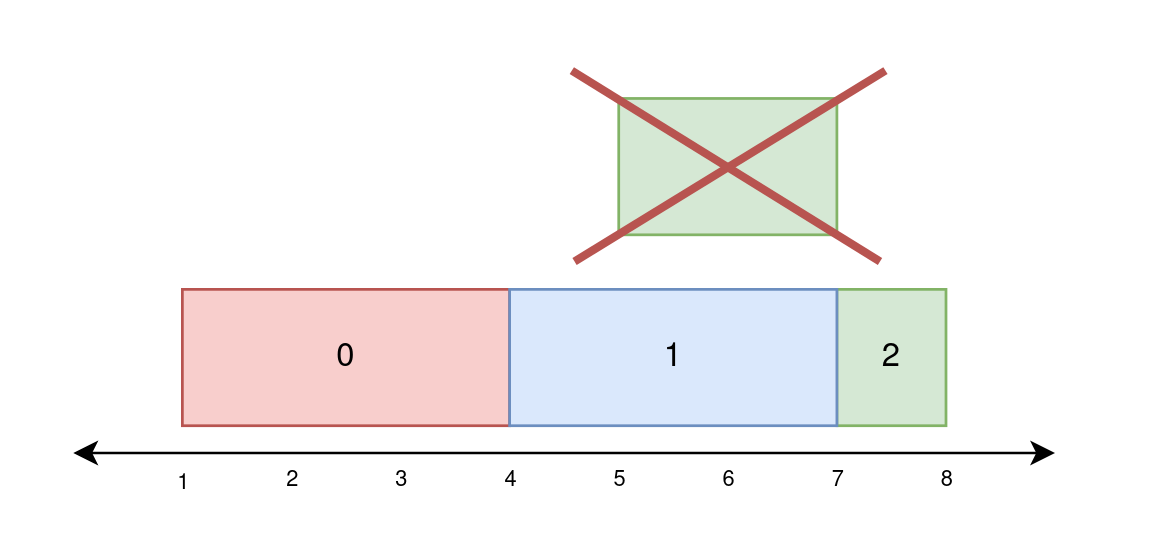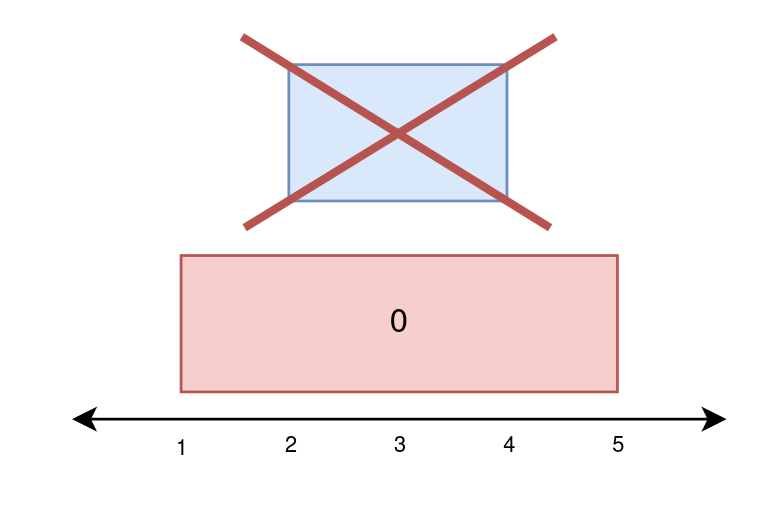2158. Amount of New Area Painted Each Day
There is a long and thin painting that can be represented by a number line.
You are given a 0-indexed 2D integer array{" "}
paint of length n, where{" "}
paint[i] = [starti, endi]
. This means that on the{" "}
ith
{" "}
day you need to paint the area between{" "}
starti
{" "}
and{" "}
endi
.
Painting the same area multiple times will create an uneven painting so you only want to paint each area of the painting at most once.
Return an integer array
worklog
of length
n
, where
worklog[i]
{" "}
is the amount of new area that you painted on the{" "}
ith
day.
Example 1:

Input: paint = [[1,4],[4,7],[5,8]]{"\n"}
Output: [3,3,1]{"\n"}
Explanation:
{"\n"}On day 0, paint everything between 1 and 4.{"\n"}The amount of new
area painted on day 0 is 4 - 1 = 3.{"\n"}On day 1, paint everything between
4 and 7.{"\n"}The amount of new area painted on day 1 is 7 - 4 = 3.{"\n"}On
day 2, paint everything between 7 and 8.{"\n"}Everything between 5 and 7 was
already painted on day 1.{"\n"}The amount of new area painted on day 2 is 8
- 7 = 1. {"\n"}
Example 2:

Input: paint = [[1,4],[5,8],[4,7]]{"\n"}
Output: [3,3,1]{"\n"}
Explanation:
{"\n"}On day 0, paint everything between 1 and 4.{"\n"}The amount of new
area painted on day 0 is 4 - 1 = 3.{"\n"}On day 1, paint everything between
5 and 8.{"\n"}The amount of new area painted on day 1 is 8 - 5 = 3.{"\n"}On
day 2, paint everything between 4 and 5.{"\n"}Everything between 5 and 7 was
already painted on day 1.{"\n"}The amount of new area painted on day 2 is 5
- 4 = 1. {"\n"}
Example 3:

Input: paint = [[1,5],[2,4]]{"\n"}
Output: [4,0]{"\n"}
Explanation:
{"\n"}On day 0, paint everything between 1 and 5.{"\n"}The amount of new
area painted on day 0 is 5 - 1 = 4.{"\n"}On day 1, paint nothing because
everything between 2 and 4 was already painted on day 0.{"\n"}The amount of
new area painted on day 1 is 0.{"\n"}
Constraints:
-
1 <= paint.length <= 105 -
paint[i].length == 2 -
0 <= starti < endi <= 5 * 104
Solution
Naive solution in
Let's split the number line into blocks such that for the th block covers the interval . Create a boolean array to store whether each block has been painted.
On day , we are tasked with painting blocks to . We can check each of these blocks, painting the unpainted ones (we also keep count of how many blocks we paint because that's what the question asks for). In the worst case, we have to check every block on every day. Let be the number of days (up to ) and let be the largest number that appears in the input (up to ). The time complexity is . This is not fast enough.
A simple solution in
Instead of using a boolean array, we can use a BBST (balanced binary search tree) to store the indices of the unpainted blocks. At the start, we insert into the BBST. When we paint a node, we delete its node from the BBST. In our time complexity analysis, it will become clear why we chose to use a BBST.
On each day, we search for the first node . If it's also , we delete it. We repeatedly do this until there are no more blocks between and .
<mark style={{ backgroundColor: "lightblue" }}>The intuition behind this solution is that we don't want need to needlessly loop over painted blocks; as soon as a block is painted, it's no longer useful, so we delete it. Otherwise, in future days, we'd have to keep checking whether each block has been painted. A BBST can do what we need: find and delete single items quickly.
Time complexity
Inserting into the BBST at the start takes time.
Finding the first node and deleting a node both take , and we do them at most and times, respectively.
In total, our algorithm takes .
Space complexity
A BBST of elements takes space.
Built-in BBSTs
Most programming languages have built-in BBSTS so we don't have to code them ourselves. C++ has set, Java has TreeSet, Python has SortedList, and JavaScript has SortedSet (but it's not supported on LeetCode).
C++ Solution
1class Solution {
2public:
3 vector<int> amountPainted(vector<vector<int>>& paint) {
4 set<int> unpainted;
5 vector<int> ans(paint.size());
6 for (int i = 0; i <= 50000; i++) {
7 unpainted.insert(i);
8 }
9 for (int i = 0; i < paint.size(); i++) {
10 int left = paint[i][0], right = paint[i][1];
11 // Repeatedly delete the first element >= left until it becomes >= right
12 // This clears values in [left, right) from the set
13 for (auto it = unpainted.lower_bound(left); *it < right; it = unpainted.erase(it), ans[i]++);
14 }
15 return ans;
16 }
17};
Java Solution
1class Solution {
2 public int[] amountPainted(int[][] paint) {
3 TreeSet<Integer> unpainted = new TreeSet<>();
4 int[] ans = new int[paint.length];
5 for (int i = 0; i <= 50000; i++) {
6 unpainted.add(i);
7 }
8 for (int i = 0; i < paint.length; i++) {
9 int left = paint[i][0], right = paint[i][1];
10 // Repeatedly delete the first element >= left until it becomes >= right
11 // This clears values in [left, right) from the TreeSet
12 while (true) {
13 int next = unpainted.ceiling(left);
14 if (next >= right)
15 break;
16 unpainted.remove(next);
17 ans[i]++;
18 }
19 }
20 return ans;
21 }
22}
Python Solution
1from sortedcontainers import SortedList 2 3class Solution: 4 def amountPainted(self, paint: List[List[int]]) -> List[int]: 5 unpainted = SortedList([i for i in range(0, 50001)]) 6 ans = [0 for _ in range(len(paint))] 7 for i in range(len(paint)): 8 left, right = paint[i] 9 # Repeatedly delete the first element >= left until it becomes >= right 10 # This clears values in [left, right) from the SortedList 11 while unpainted[ind := unpainted.bisect_left(left)] < right: 12 unpainted.__delitem__(ind) 13 ans[i] += 1 14 return ans
JavaScript Solution
1var SortedSet = require("collections/sorted-set");
2/**
3 * @param {number[][]} paint
4 * @return {number[]}
5 */
6var amountPainted = function (paint) {
7 const n = paint.length;
8 const ans = new Array(n).fill(0);
9 const unpainted = new SortedSet(Array.from(Array(50001).keys()));
10 for (let i = 0; i < n; i++) {
11 (left = paint[i][0]), (right = paint[i][1]);
12 // Repeatedly delete the first element >= left until it becomes >= right
13 // This clears values in [left, right) from the SortedSet
14 while ((node = unpainted.findLeastGreaterThanOrEqual(left)).value < right) {
15 unpainted.delete(node.value);
16 ans[i]++;
17 }
18 }
19 return ans;
20};
Alternative solution
Instead of storing the unpainted blocks, we can store the painted segments. We store them as (left, right) pairs in a BBST, where no segments intersect. Each day, we delete segments fully contained in [left_i, right_i], then merge partially overlapping segments with it, all while keeping count of how many blocks we've painted this day. We create, delete, and check for overlaps in segments for a total time complexity of . This solution is trickier to implement—code will not be presented here.
Which of these properties could exist for a graph but not a tree?
What is the worst case running time for finding an element in a binary search tree(not necessarily balanced) of size n?
Solution Implementation
Which of the following shows the order of node visit in a Breadth-first Search?

Which technique can we use to find the middle of a linked list?
Recommended Readings
Top Patterns to Conquer the Technical Coding Interview Should the written word bore you fear not A delightful video alternative awaits iframe width 560 height 315 src https www youtube com embed LW8Io6IPYHw title YouTube video player frameborder 0 allow accelerometer autoplay clipboard write encrypted media gyroscope picture in picture
Recursion Recursion is one of the most important concepts in computer science Simply speaking recursion is the process of a function calling itself Using a real life analogy imagine a scenario where you invite your friends to lunch https algomonster s3 us east 2 amazonaws com recursion jpg You first
Runtime Overview When learning about algorithms and data structures you'll frequently encounter the term time complexity This concept is fundamental in computer science and offers insights into how long an algorithm takes to complete given a certain input size What is Time Complexity Time complexity represents the amount of time
Got a question? Ask the Teaching Assistant anything you don't understand.
Still not clear? Ask in the Forum, Discord or Submit the part you don't understand to our editors.